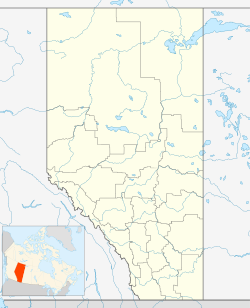Blairmore, Alberta
| Blairmore | |
|---|---|
| Location of Blairmore in Alberta | |
| Coordinates: 49°36′29″N 114°26′34″W / 49.6081°N 114.4428°WCoordinates: 49°36′29″N 114°26′34″W / 49.6081°N 114.4428°W | |
| Country |
|
| Province |
|
| Census division | No. 15 |
| Specialized municipality | Municipality of Crowsnest Pass |
| Government | |
| • Type | Unincorporated |
| • Governing body | Municipality of Crowsnest Pass Council |
| Population (2006) | |
| • Total | 2,088 |
| Time zone | MST (UTC−7) |
| • Summer (DST) | MDT (UTC−6) |
Blairmore is an urban community in the Rocky Mountains within the Municipality of Crowsnest Pass in southwest Alberta, Canada. It was formerly incorporated as a town prior to 1979 when it amalgamated with four other municipalities to form Crowsnest Pass. Blairmore is the principal commercial centre of Crowsnest Pass.
Originally a Canadian Pacific Railway stop called Tenth Siding or The Springs (for the cold sulphur spring to the east), the settlement was renamed Blairmore in November 1898 and it got a post office the following year. A ten-year dispute over land ownership between the CPR station agent and the section foreman stunted early development. Blairmore’s principal industry was lumber and, after 1907, coal. Other industries followed and on September 29, 1911 Blairmore was incorporated as a town. With the declining fortunes of the nearby community of Frank, Blairmore soon became the region’s economic centre. The Greenhill mine, located just north of Blairmore, became the mainstay of the community until its closure in 1957.
One of the town’s early characters was Emilio Picariello (1875 – 1923). “Emperor Pic” settled in Blairmore in 1918 and operated several businesses, but also illegally imported alcohol from nearby British Columbia during prohibition. Picariello and Florence Lassandro were hanged in 1923 after the shooting death of Alberta Provincial Police constable Steve Lawson in 1922.
Like many Canadian industrial towns in the 1930s, Blairmore had some sympathies with Communism. Canada's first Communist town council and school board were elected in Blairmore in 1933, which reformed the tax system, and refused to observe Remembrance Day as an Imperialist holiday and honoured the Russian Revolution instead. A street was named after the leader of the Communist Party of Canada, Tim Buck, a decision that was reversed by the next town council.
...
Wikipedia

